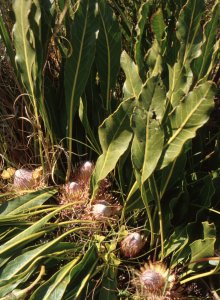
Home
Mission
Overview of Project
Project Staff
Sponsors
Achievements
Checking, Illustrations
Upcoming Activities
Id and Species Lists
Protea Information
Protea Gallery
Growing Proteas
Interim Dist. Maps
Publications
Afrikaanse Inligting
![]()
Resprouting in the Western Ground and Snow Proteas
 Considerable confusion exists for some atlassers between the identification
of two pairs of proteas. Both of these are similar sister species that differ chiefly in
their response to fire. Among the Western Ground Sugarbushes we have Common Ground Sugarbush - Protea acaulos vs Smooth-Leaf Sugarbush - Protea laevis and in the
Snow Sugarbushes Hart's-Tongue-Fern Sugarbush - Protea scolopendriifolia
vs Protea scabriuscula. In both cases the more widespread species resprouts
from underground stems and the more local species is reputedly killed by fire.
Considerable confusion exists for some atlassers between the identification
of two pairs of proteas. Both of these are similar sister species that differ chiefly in
their response to fire. Among the Western Ground Sugarbushes we have Common Ground Sugarbush - Protea acaulos vs Smooth-Leaf Sugarbush - Protea laevis and in the
Snow Sugarbushes Hart's-Tongue-Fern Sugarbush - Protea scolopendriifolia
vs Protea scabriuscula. In both cases the more widespread species resprouts
from underground stems and the more local species is reputedly killed by fire.
So what is the problem? Most atlassers should be up to identifying whether a protea is killed or survives fires by resprouting from its underground stems. The problem is that proteas have not read the books yet. In both cases the plants that are supposed to be killed are surviving fires. This is confusing many experienced atlassers. What is happening?
The Smoothleaf Sugarbush Pr laevis differs from the Common Ground Sugarbush Pr acaulos in that its stems lie on top of the ground. If they would stay there then there would be no confusion. However, with time, the stems trap sand or loam and thus become partially buried. Thus cooler fires tend not to kill the plants and stems survive to regrow. Following the fire, more sand is trapped and the plants may form large mats that can survive several fire cycles. However, tugging at the stems will result in the branches lifting clear of the soil (and therefore be susceptible to the next fire, so please put it back). A few very weak, hair-like roots may just be visible, but the stems seem not to be able to form any substantial roots. Contrast this with Pr acaulos, that has tough, robust, woody underground stems (you will need a spade), with only short sections - seldom even to half a metre - free on the surface. Thus the general appearance of mature plants is of a mat for Pr laevis and isolated tufts in Pr acaulos. Young plants might look similar, but Pr acaulos would produce underground stems whereas Pr laevis would be single-stemmed at the base (in old plants locating the single basal stem may be problematic).
According to John Rourke, there is no difference in the flowers or flowerheads – the difference is purely one of growth habit, plus the tendency for Pr laevis to have fleshy, soft leaves (versus hard and woody) and a tendency to produce long, soft, brown leaf-scales at the beginning of every growth spurt along the stem (these are almost insignificant in Pr acaulos).
This means we have to reassess the distributions of these two species based on atlasser data. The smaller form of Pr laevis (the big form, with the large fleshy leaves, is unmistakable) appears to occur in more arid regions, whereas Pr acaulos is more coastal and generally absent from the eastern Cederberg and KoueBokkeveld Mountains. Although we have rediscovered the population on the Langeberg at Grootvadersbos, it is largely confined to mountains west of the KoueBokkveld and Worcester Valley and the Riviersonderend. Please check your data!
The situation with the Hoary Sugarbush Pr scabriuscula is very similar. This species is supposed to be killed by fire. It forms a dense, low, cushion-like, clump of stems on the ground, hidden underneath the leaves. Like Pr laevis, it traps soil and thus survives fire well – this has been recorded on Matroosberg and Skurweberg-Sneeuberg. Its mode of growth is quite unlike that of the Hart’s-tonguefern Sugarbush Pr scolopendriifolia, which has underground stems. However, the dense foliage and trapped soil may make this difference difficult to see. Usually Pr sscl forms a rounded cushion, whereas dense patches of Pr srfl have clumps of leaves arising flat on the ground. The two species may additionally be told apart by the narrower leaves of Pr sscl (5-20 mm wide, very rarely to 30 mm vs 20-85 mm wide in Pr srfl), with very wavy margins (vs flat). The flowerhead is also smaller (up to 60 mm across vs 60-120 mm across in Pr srfl).
As far as we know Pr scabriuscula only occurs on Matroosberg and the peaks around the KoueBokkeveld - most prominently Sneeuberg (Skurweberg), with range extensions to Gideonskop. Odd plants occur on the floor of the KoueBokkeveld (near Klondyke and Lakenvlei). By contrast, Pr scolopendriifolia occurs from the Cederberg to the Kouga. Both species prefer the Cederberg Shale formation, but are not confined to it.
I hope that that clears up any confusion. If you think that you have made an error with any of these four species, please contact us.
Tony Rebelo
Back PAN 47